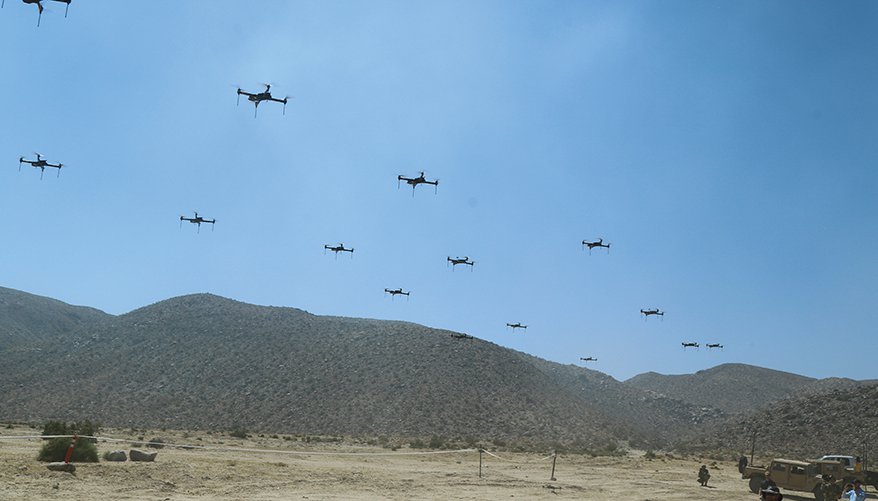ARMY NEWS
JUST IN: Kamikaze Drone Threat Putting Air Defense Back in Army Maneuver Formations
By Stew Magnuson
 Army officials operate a swarm of drones during an exercise at the National Training Center in Fort Irwin, California.
Army officials operate a swarm of drones during an exercise at the National Training Center in Fort Irwin, California.
The use of loitering munitions on modern battlefields is forcing the Army to consider merging the now segregated worlds of long-range offensive fires and air defense, one of the service’s top officers said June 3.
“Air and missile defense, counter-UAS capability has to get back into our combined arms maneuver, all arms maneuver formations,” Army Futures Command leader Gen. James Rainey said at a Center for Strategic and International Studies talk.
“We should do it right now,” he added.
The use of loitering munitions, also called kamikaze drones, has been a hallmark of the Ukraine war, and militaries throughout the world are adopting the tactic, including the U.S. military, which is pursuing drone swarms to overwhelm opponents under its Replicator initiative.
The problem has given rise to a new buzzword in the Army that Rainey mentioned several times, “air littorals,” meaning contested airspace closer to the ground.
There are many places where air and missile defense and long-range fires can converge, Rainey said. He didn’t advocate merging the two skill sets, but forces on the move will be transporting different radar systems, command systems and taking orders from different officers.
“We're not going to have the luxury of having two bespoke systems,” he said.
Using the same munitions for both long-range fires or air defense won’t be a major problem, but the fact that they have different command-and-control systems is complicated, he said.
As far as having different air defense and fire branches, Rainey said he thought it was time to consider whether it would be beneficial to merge part of the two, although he stressed that was his own thinking, not necessarily the Army’s.
“It's just becoming one thing. You can't treat this different than this. If somebody shoots at you, you got to kill them,” he said.
The Army is playing catch up on counter-drone technology, he said, although he stressed that a combined maneuver force has a lot more at its disposal than technology.
“If somebody was flying UAS at us, we would fight the UAS but we would also be fighting wherever they came from,” he said, adding that the joint force would also be brought to bear.
“The Army I grew up in — infantry, armor, artillery, air defense … engineers — combined arms, the five finger death punch, right. So, we got to get that back into our formations at echelon,” he said.
He likened counter-drone skills to chemical, biological and nuclear protection. It is something every soldier should be familiar with. There is no reason why warrant officers or platoon sergeants, for example, shouldn’t be able to jump from operating a long-range fires system to an air defense system, he said.
Both air defense and long-range fires now reside at Fort Sill, Oklahoma, he noted. When the Air Defense Artillery School moved from Fort Bliss, Texas, to Fort Sill, Oklahoma, in 2010, Rainey said he questioned why the Army forced the change. Today, he said, “that was exactly the right thing to do.” Yet, he still described the two communities as “two different tribes.”
Ultimately, the leaders at the Combined Arms Center at Fort Leavenworth, Kansas, and those at Fort Sill are “going to figure this out,” he said.
Topics: Missile Defense
